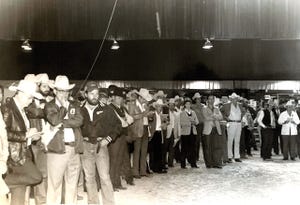Cattle Feedlot Housing Systems Compared
Research Roundup discusses a new study from South Dakota State University on cattle feedlot housing systems. It also discusses an Oklahoma State University study that evaluates different castration methods.
June 1, 2011

Three years of feedlot close-out records and the actual construction costs adjusted for inflation were used by South Dakota State University economics and animal sciences researchers to establish which of three cattle-feeding systems was the most cost effective in southeastern South Dakota. Compared were: open pen (OP), open pen with shelter (OS), and total confinement (CF). Each system was built to accommodate 80 cattle per pen in each of the four pens.
• OP allowed 275 sq. ft./head of dirt pen surface area, a 12-ft. concrete feed apron, and 8-ft.-high dirt mounds sloping toward the back and center of the pen.
• OS allowed 215 sq. ft./head of dirt pen surface area, 3-ft.-high dirt mounds, and a concrete-floored monoslope building covering the feed alley, bunk and front 20 ft. of the pen.
• CF allowed 45 sq. ft./head of concrete surface area and was bedded weekly with corn stover.
Fixed costs included the required land area and facility construction for each system, amortized over 20 years at 90% occupancy. Total fixed costs were $551, $767 and $687/head of capacity for OP, OS and CF, respectively.
Daily non-feed-related costs for labor, equipment and bedding were logged over a 36-month period to determine variable costs. Total daily variable costs were $125, $150 and $326/1,000 head for OP, OS and CF, respectively.
Combined fixed/variable costs were $5.91, $7.31 and $12.02/cwt. of gain.
Cattle performance was determined from 24 matched pen close-outs for each system. Cattle fed in partial or total confinement systems outperformed cattle in the open system. Daily gain was less, and feed-to-gain was greater, for OP compared to OS or CF cattle. Actual gain was 3.51, 3.62 and 3.57 lbs./day, respectively; while feed-to-gain was 7.00, 6.77 and 6.75 lbs./day for OP, OS and CF, respectively.
Comparing the OP and CF systems and accounting for total differences in fixed and variable costs and cattle performance, feed costs must reach $489/ton before CF becomes a cost-competitive alternative to OP in feedyard design.
Though the most expensive to build, OS was the most cost-competitive design and equaled OP at a ration cost of $122/ton. This emphasizes the need to consider the cumulative effects of fixed and variable costs as well as cattle performance.
Other factors to consider are land value and local environmental regulations.
Castration Methods Compared >>
Castration Methods Compared
It’s well documented that castrating bulls upon arrival at feeding operations is detrimental to health and performance. Still, bulls continue to comprise a high percentage of cattle sold through auction markets.
In two studies, Oklahoma State University researchers evaluated two castration methods in high-risk auction market feeder bulls. Compared were surgical (S) (Newberry knife) and non-surgical (NS) (Callicrate bander). Bulls were processed and castrated 24-72 hours after arrival. Banded bulls were administered a tetanus toxoid; all other processing procedures were identical.
In study 1, 272 bulls averaging 580 lbs. were compared over 42 days. Morbidity was higher in S compared to NS, 29.4 vs. 19.1%, but mortality didn’t differ. Dry matter intake and daily gain averaged 12.6 and 1.52 lbs./day, respectively, and were unaffected by castration method.
In study 2, 266 bulls averaging 587 lbs. were compared over 53 days. Morbidity was higher in S than NS, 61.7 vs. 40.6%, but mortality did not differ. Daily gain averaged 1.59 lbs./day and was not affected by castration method.
Another important factor to consider is that banded bulls are less of a health risk than surgically castrated bulls.
For the full report, go to: http://amarillo.tamu.edu/amarillo-center-programs – pages 100 and 119 of 2011 Proceedings
You May Also Like
.png?width=300&auto=webp&quality=80&disable=upscale)


